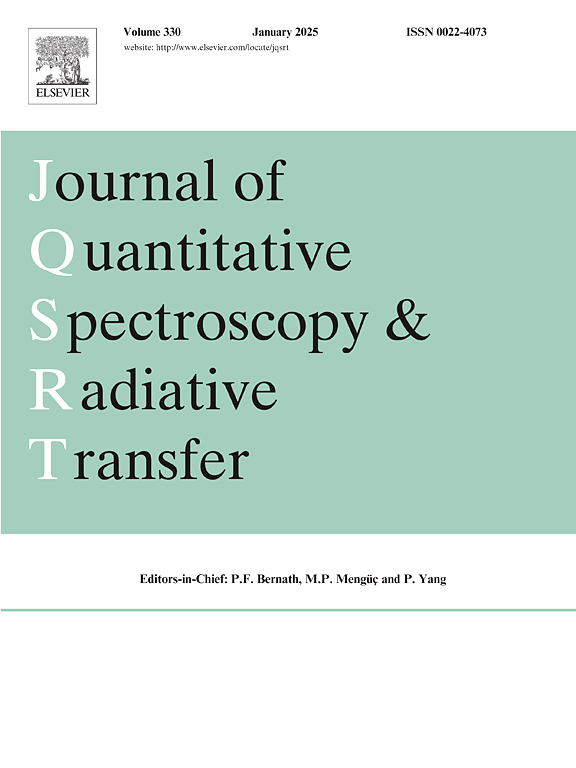用于非线性激光吸收层析成像的物理信息神经网络
IF 2.3
3区 物理与天体物理
Q2 OPTICS
Journal of Quantitative Spectroscopy & Radiative Transfer
Pub Date : 2024-10-31
DOI:10.1016/j.jqsrt.2024.109229
引用次数: 0
摘要
高光谱吸收层析成像技术因其丰富的光谱测量而成为一种前景广阔的燃烧诊断技术。然而,由于逆问题的非线性和多假设性质,获得精确结果具有挑战性。本文提出了一种物理信息神经网络的新应用,以解决高光谱吸收光谱学中的非线性逆问题。该方法利用物理定律和测量数据指导神经网络找到最优解,而无需训练数据。为了证明神经网络的能力,我们采用了物理信息神经网络,通过 4.3μm TDLAS(可调谐二极管激光吸收光谱)检索轴对称层流扩散火焰中的温度场和二氧化碳摩尔分数场。所开发的神经网络用于从光谱维度解析空间分布,从而减少了直接检索温度和二氧化碳分子分数剖面所需的空间测量。我们研究了精确检索所需的最小径向投影,并通过模拟火焰的反演评估了模型对随机噪声的鲁棒性。开发的模型还被进一步应用于重建实验测量火焰的温度场和二氧化碳分子分数场。结果表明,即使在数据有限、噪声较大的情况下,所提出的模型仍能保持较高的检索精度。这项工作凸显了物理信息神经网络在科学和工程应用中稳健解决非线性激光吸收层析成像问题的潜力。本文章由计算机程序翻译,如有差异,请以英文原文为准。
A physics-informed neural network for non-linear laser absorption tomography
Hyperspectral absorption tomography has emerged as a promising technique for combustion diagnostics due to its rich spectral measurements. However, the non-linear and ill-posed nature of the inverse problem makes obtaining accurate results challenging. This paper proposes a novel application of a physics-informed neural network to address the non-linear inverse problem in hyperspectral absorption spectroscopy. This method utilizes physical laws and measurement data to guide the neural network in finding the optimal solution, without requiring training data. To demonstrate its capabilities, the physics-informed neural network is employed to retrieve temperature and CO mole fraction fields in axisymmetric laminar diffusion flames via TDLAS (tunable diode laser absorption spectroscopy). The developed neural network is applied to resolve the spatial distributions from the spectral dimensions, requiring fewer spatial measurements for directly retrieving temperature and CO mole fraction profiles. We investigate the minimum radial projections needed for accurate retrievals and evaluate the model’s robustness to random noise through the inversion of a simulated flame. The developed model is further applied to reconstruct the temperature and CO mole fraction fields for an experimentally measured flame. Our results demonstrate that the proposed model maintains high retrieval accuracy even with limited, noisy data. This work highlights the potential of the physics-informed neural network for robust solutions to non-linear laser absorption tomography problems in scientific and engineering applications.
求助全文
通过发布文献求助,成功后即可免费获取论文全文。
去求助
来源期刊
CiteScore
5.30
自引率
21.70%
发文量
273
审稿时长
58 days
期刊介绍:
Papers with the following subject areas are suitable for publication in the Journal of Quantitative Spectroscopy and Radiative Transfer:
- Theoretical and experimental aspects of the spectra of atoms, molecules, ions, and plasmas.
- Spectral lineshape studies including models and computational algorithms.
- Atmospheric spectroscopy.
- Theoretical and experimental aspects of light scattering.
- Application of light scattering in particle characterization and remote sensing.
- Application of light scattering in biological sciences and medicine.
- Radiative transfer in absorbing, emitting, and scattering media.
- Radiative transfer in stochastic media.

 求助内容:
求助内容: 应助结果提醒方式:
应助结果提醒方式:


